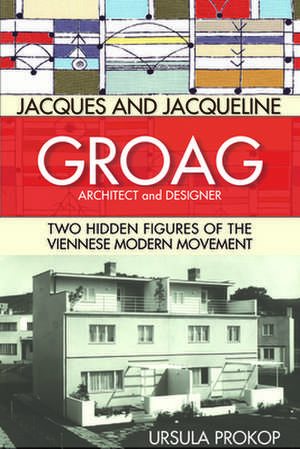Jacques and Jacqueline Groag, Architect and Designer
Autor Ursula Prokop Traducere de Laura McGuireen Limba Engleză Hardback – 15 aug 2019
Preț: 237.33 lei
Nou
Puncte Express: 356
Preț estimativ în valută:
45.41€ • 47.41$ • 37.58£
45.41€ • 47.41$ • 37.58£
Carte disponibilă
Livrare economică 15-29 martie
Preluare comenzi: 021 569.72.76
Specificații
ISBN-13: 9780999754436
ISBN-10: 0999754432
Pagini: 272
Dimensiuni: 235 x 158 x 23 mm
Greutate: 0.73 kg
Editura: DoppelHouse Press
ISBN-10: 0999754432
Pagini: 272
Dimensiuni: 235 x 158 x 23 mm
Greutate: 0.73 kg
Editura: DoppelHouse Press
Cuprins
Introduction
The Early Years The background and education of Jacques Groag
World War I and professional beginnings
The First Projects
Collaboration on the Wittgenstein House, 1926¿29
The Moller Villa, 1927¿1928
The first independent project: The Groag Villa in Olmütz, 1927¿1928
Viennäs artistic environment
The Artistic Breakthrough
Projects in Vienna and Moravia – first success as an interior architect
Getting to know Hilde Blumberger
The duplex at the Vienna Werkbundsiedlung, 1931–1932
Furniture and interiors
The Gustav Stern House in Perchtoldsdorf, 1932/33
The Paula and Hans Briess Villa in Olmütz, 1933
Projects in the Late 1930s
Ing. Rudolf Seidler Villa in Olmütz, 1935
Conversion and furnishings of the Paula Wessely Villa in Vienna-Grinzing, 1935
Otto Eisler country house in Ostravice, 1935–1939
The late 1930s ¿ various projects in Moravia-Ostrau and Brno
Displacement and intermezzo in Prague, 1938–1939
Emigration and a New Beginning in England
Escape and a difficult start
The end of the war – an urban planning project for Soho, 1945
Jacqueline Groag establishes herself as a textile designer
The emigrants in England – a problematic situation
The Groags After the War – Utility Furniture and Exhibition Design
The utility furniture program – a new arena
The first postwar exhibitions – Modern Homes and Britain Can Make It, 1946
Further exhibitions – Ideal Home, 1949 and British Industries Fair, 1950
The end of the postwar era – The Festival of Britain, 1951
The 1950s – Jacques Groag¿s interiors and painting as therapy
The late work of Jacqueline Groag
Conclusion
Jacques Groag – Catalog of Works
Architecture, interior design and furniture design
Painting and graphic art
Professional articles and publications
Bibliography
Monographs, catalogs, and articles
Unpublished typescripts and manuscripts
Periodicals – Jacques Groag
Periodicals – Jacqueline Groag
Archives and private sources
The Early Years The background and education of Jacques Groag
World War I and professional beginnings
The First Projects
Collaboration on the Wittgenstein House, 1926¿29
The Moller Villa, 1927¿1928
The first independent project: The Groag Villa in Olmütz, 1927¿1928
Viennäs artistic environment
The Artistic Breakthrough
Projects in Vienna and Moravia – first success as an interior architect
Getting to know Hilde Blumberger
The duplex at the Vienna Werkbundsiedlung, 1931–1932
Furniture and interiors
The Gustav Stern House in Perchtoldsdorf, 1932/33
The Paula and Hans Briess Villa in Olmütz, 1933
Projects in the Late 1930s
Ing. Rudolf Seidler Villa in Olmütz, 1935
Conversion and furnishings of the Paula Wessely Villa in Vienna-Grinzing, 1935
Otto Eisler country house in Ostravice, 1935–1939
The late 1930s ¿ various projects in Moravia-Ostrau and Brno
Displacement and intermezzo in Prague, 1938–1939
Emigration and a New Beginning in England
Escape and a difficult start
The end of the war – an urban planning project for Soho, 1945
Jacqueline Groag establishes herself as a textile designer
The emigrants in England – a problematic situation
The Groags After the War – Utility Furniture and Exhibition Design
The utility furniture program – a new arena
The first postwar exhibitions – Modern Homes and Britain Can Make It, 1946
Further exhibitions – Ideal Home, 1949 and British Industries Fair, 1950
The end of the postwar era – The Festival of Britain, 1951
The 1950s – Jacques Groag¿s interiors and painting as therapy
The late work of Jacqueline Groag
Conclusion
Jacques Groag – Catalog of Works
Architecture, interior design and furniture design
Painting and graphic art
Professional articles and publications
Bibliography
Monographs, catalogs, and articles
Unpublished typescripts and manuscripts
Periodicals – Jacques Groag
Periodicals – Jacqueline Groag
Archives and private sources
Notă biografică
Jonee Tiedemann is a certified translator and interpreter from Germany who lives in Argentina, has studied in the United States, and works between the three languages: German, Spanish and English. He specializes in architecture and design books, as well as self-published German indie literature.
